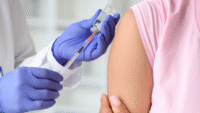Improving nurse confidence can boost vaccination rates.
- The COVID-19 pandemic highlighted the public health concerns of low vaccine uptake in the United States for vaccine-preventable illnesses.
- Healthcare providers need the confidence and knowledge to have quality vaccination conversations with their patients.
- Nurses, because of their various roles in healthcare, are well positioned to have a positive impact on vaccination efforts through patient education.
Historically, vaccination rates among college students, specifically for human papillomavirus (HPV) and seasonal influenza, have run low. The same trend has occurred with COVID-19 vaccination. D’Errico and colleagues found that most vaccination barriers center on a lack of health literacy regarding a disease and its vaccine as well as a misunderstanding of an illness’s potential risk.
Combat healthcare untruths with community outreach
Do polio and smallpox present a threat?
The COVID-19 pandemic and anticipated prevalence of illness impacting healthcare systems for years to come create an ongoing need for higher rates of vaccination among all populations to reduce disease transmission, serious illness, and death. Ryan and colleagues identified educational outreach and provider recommendation as successful strategies for increasing seasonal influenza and HPV vaccination rates. These same strategies also can help increase COVID-19 vaccination rates in low-uptake populations. (See Ongoing impact of COVID-19.)
Ongoing impact of COVID-19
Annual COVID-19 vaccination leads public health strategies to limit virus mutation and disease transmission. During the pandemic, the United States struggled with uncontrolled spread of the virus. In May 2024, the Centers for Disease Control and Prevention (CDC) reported 1.19 million deaths (since the start of the pandemic in March 2020) due to complications from COVID-19. According to the Johns Hopkins Research Center (JHRC), compared to peer countries such as Australia, Canada, and France, the United States has more than double the excess mortality rate from COVID-19 for people under age 65 and trails all ten peer countries in vaccination rates. When the JHRC ceased operation in March 2023, it reported over 103 million confirmed cases of COVID-19 in the United States. In addition, Peterson-KFF Health System Tracker estimates that since May 2021, when vaccines became widely available, more than 234,000 preventable deaths from COVID-19 have occurred in the United States; this number continues to rise.
In May 2023, when the CDC stopped reporting vaccination data by age group, only 66.8% of 18- to 24-year-olds and only 72.2% of 25- to 49-year-olds had received the primary series of COVID-19 vaccinations. These numbers demonstrate the lowest uptake of any adult age group for the COVID-19 vaccine series and booster at that point. As recently as January 10, 2024, the Food and Drug Administration (FDA) raised the alarm on the increasing number of people in the United States declining vaccination, stating that only 19% of the adult population has received their annual COVID-19 vaccination, which they state will lead to “thousands of needless deaths.”
In January 2024, the United States was still seeing over 1,000 deaths a week from COVID-19. Although the reporting requirement has since ceased, this demonstrates the ongoing need for vaccination education and recommendation despite being out of the crisis stages of the pandemic. FDA Commissioner Robert Califf called on healthcare professionals to take every chance to provide patients with credible information about vaccination and to speak up on the benefits of vaccination in an effort to combat the increasing spread of misinformation.
To address this issue, a team of nurses at a large public research university undertook a project to better understand vaccine hesitancy among college students and help nurses and providers tackle this hesitancy.
Background and significance
Previous vaccine research has focused on college students because of the potential for high-risk behaviors and density of college campus environments. Sandler and colleagues noted that college students begin making their own healthcare decisions, frequently for the first time, with less parental influence. This presents an opportunity for nurse practitioners in college health and primary care settings to have conversations and provide education. In addition, these highly populated college environments increase the risk of exposure to vaccine-preventable diseases, such as HPV, influenza, and COVID-19.
Barriers
Several barriers lead to college student vaccine hesitancy. For example, Gandhi and Bozer found that declining flu vaccination rates among college students stem from many perceiving a low threat of illness or believing that they’re not susceptible. D’Errico and colleagues also noted underestimation of risk as one of the most common reasons students choose not to receive the HPV vaccine. Regardless of the disease, college students consistently identify themselves as having a low risk of contracting the illness or becoming seriously ill.
Another common barrier includes false or misleading content (infodemic, a term coined by the World Health Organization [WHO]). In July 2021, U.S. Surgeon General Vivek Murthy declared COVID-19 misinformation a “serious public health threat,” and the WHO deemed misinformation a major factor driving continuation of the pandemic.
Silva and colleagues reported that, during the pandemic, almost 80% of adults age 18 to 24 years and 60% of college students used at least one social media platform to receive information about COVID-19. Lucia and colleagues highlighted the vaccine hesitancy associated with misinformation from social media or peers, emphasizing the importance of easily understood accurate information from a trusted source, such as a healthcare professional.
Strategies
Both Ryan and Silva, along with their colleagues, identified provider recommendation as the strongest predictor of HPV, influenza, and COVID-19 vaccine uptake. Czajka and colleagues noted that most people rank providers as the most trusted sources of health information and that provider education impacts vaccination-related attitudes and decisions more than the media or family members. Ryan and colleagues also reported that college students prefer to receive education about influenza from a healthcare provider.
Literature review
In January 2022, we conducted an exhaustive literature search to identify sources for answering the following initial PICOT (Population, Intervention, Comparison/Control, Outcome, Time) question: “In college students, age 18 to 30 years, how does provider education influence decision-making regarding vaccine uptake?” Upon further research, we changed the project focus and PICOT to the following: “In college health providers, how does education influence confidence levels in vaccination recommendation and education to vaccine-hesitant populations?”
Out of 52 articles, we selected 11 for critical appraisal (five cross-sectional/descriptive studies, two cohort studies, one qualitative study, one quasi-experimental survey-based intervention study, and two systematic literature reviews). Provider recommendation, regardless of vaccine type, emerged as the strongest influencer of vaccine uptake for college students. Increasing knowledge of the targeted illness (including severity and susceptibility) and the vaccine also proved an effective strategy. Nurses, as the largest group of healthcare professionals (nearly four times the size of the physician workforce), can significantly impact vaccination rates among college students by providing education and recommendations.
Using this evidence, we developed an educational intervention focused on college health service providers (most nurse practitioners [NPs]).
The project
The university’s institutional review board approved the project as exempt. To protect the rights of participants, we obtained informed consent via a question at the beginning of a survey. We received human subjects research training for biomedical, social, behavioral, and education research through the CITI program.
Instrumentation and data collection
To measure outcomes, we adapted two instruments (with permission)—the Determinants of Intentions to Vaccinate (DIVA) survey, a tool developed by the French Society of General Internal Medicine, and the Center for Immunization Research and Education (CIRE) pilot survey created by Dysband. Collected demographics included participant age, gender, degree/role, years of experience, vaccine-hesitant patient frequency, and vaccine conversation frequency. We used unique identifiers for each participant to protect their privacy. (See Participant demographics)
Participant demographics
We collected demographic data from all intervention participants, including the frequency of vaccine-hesitant patients and vaccine conversations.
| Variable | Number | Percentage |
| Gender | ||
| Female | 14 | 82.35% |
| Male | 3 | 17.65% |
| Age range | ||
| 40–49 | 8 | 47.06% |
| 50–59 | 4 | 23.53% |
| 30–39 | 3 | 17.65% |
| 60–69 | 2 | 11.76% |
| Years of experience | ||
| >7 years | 11 | 64.71% |
| 5–7 | 4 | 23.53% |
| 3–5 | 2 | 11.76% |
| Role | ||
| Nurse practitioner | 14 | 82.35% |
| Physician | 3 | 17.65% |
| Frequency of vaccine conversations | ||
| >75% of visits | 8 | 47.06% |
| 25%–50% of visits | 5 | 29.41% |
| 50%–75% of visits | 4 | 23.53% |
| Frequency of vaccine-hesitant patients | ||
| Daily | 9 | 52.94% |
| Weekly | 5 | 29.41% |
| Monthly | 2 | 11.76% |
| Hourly | 1 | 5.88% |
Population and setting
Eligible participants included providers working at health clinic locations within a single university in the southwest United States. Most were full- or part-time NPs. In addition, we selected only participants willing to take part in all aspects of the project (pre-survey, educational intervention, and post-surveys) and who encounter patients daily as their primary role. Exclusion criteria included any nurse who didn’t primarily provide direct patient care.
Methods
We covered several topics in the educational presentation to the health providers, including COVID-19 vaccine types and information; important virus material to share with college students; where to receive reliable vaccine information; common myths and misconceptions and strategies for dispelling them; vaccine safety, efficacy, and risks; and motivational interviewing techniques. Due to the pandemic, we offered the one-time session as a live webinar. Participants received educational handouts via email. All materials used information and evidence from peer-reviewed sources as well as from the WHO, Centers for Disease Control and Prevention, Johns Hopkins Coronavirus Research Center, and the National Institutes of Health.
Before the educational session, participants received a pre-survey to rate their confidence levels (using a Likert scale—from 1 = strongly disagree to 5 = strongly agree), as well as questions related to how frequently they see vaccine-hesitant patients and have conversations about vaccines. They then completed two post-intervention surveys to rate the confidence levels 1 week and 8 weeks after the presentation.
Findings


At the 8-week post-survey, participants also reported increased confidence in vaccine conversation behaviors. An increased confidence in the ability to provide a strong recommendation for vaccination to patients has clinical significance because, as noted in the literature, a strong healthcare provider recommendation serves as a top motivator for vaccine uptake among college students. With proper education and tools, providers can speak confidently with patients about vaccination. (See Increasing confidence.)
Of the 17 pre-survey participants, almost 53% reported encountering vaccine-hesitant patients daily, underscoring the importance of this topic. In addition, 47% said that 75% of patient visits include vaccine conversations, indicating the regular occurrence of vaccine conversations at this university. (See Vaccine hesitance frequency.)
Limitations and challenges
We encountered several limitations and barriers to this project. For example, the COVID-19 pandemic presented significant challenges. In addition to taking responsibility for the health services of the university’s student, faculty, and staff populations, members of our organization also served as primary contact tracers and provided vaccines to any faculty, student, or staff who requested them. This increased workload limited the time available to deliver the educational intervention and reduced participants’ willingness to complete surveys.
Although 17 providers participated in the educational intervention and completed the pre-survey, only 13 completed the 1-week post-survey, and only eight completed the 8-week post-survey. Of those eight, only four used the same unique identifier for each survey, making it difficult to demonstrate statistical significance when comparing surveys. Time and other constraints also reduced our ability to collect data on vaccination rates and any impact the intervention had on this metric.
Despite these limitations, we collected valuable information regarding the frequency of vaccine conversations, number of vaccine-hesitant patients, and the role providers can play in providing strong recommendations and education.
Nursing implications


Stay up-to-date and aware of the current literature on common vaccinations (such as influenza, COVID-19, and HPV), as well as any others common for the population you serve. Seek training and education on communication techniques, such as motivational interviewing, and stay open to conversations that may include hard questions that require debunking myths.
Always remember that you have a voice with valuable insights and knowledge to advocate for healthcare and patients. Use your voice to support accurate information that’s readily and easily accessible for all patients.
Confidence boost
In early 2024, the WHO reported that over 10,000 preventable COVID-19 deaths worldwide (most in the Americas and Europe) occurred in December 2023 alone. Public health officials turning their focus to long-term management of COVID-19 underscores the importance of annual vaccination for this disease.
Increasing provider confidence via targeted education and tips for offering a strong recommendation, such as motivational interviewing, serves as a successful strategy for improving vaccine uptake rates. Vaccine conversations about COVID-19 also benefit discussions about other vaccine-preventable diseases, such as seasonal influenza and HPV. Primary care settings, including college health services, should implement onboarding education about vaccine conversations and provider recommendations for all nurses and NPs, as well as competency validation and ongoing training.
The authors work at Arizona State University in Phoenix. Natalie Heywood is director of the MS nursing programs and a clinical associate professor. Katherine Kenny is associate dean of the academic enterprise.
American Nurse Journal. 2024; 19(7). Doi: 10.51256/ANJ072418
References
Amin K, Ortaliza J, Cox C, Michaud J, Kates J. COVID-19 mortality preventable by vaccines. Peterson-KFF Health System Tracker. April 21, 2022. www.healthsystemtracker.org/brief/covid19-and-other-leading-causes-of-death-in-the-us/
Centers for Disease Control and Prevention. COVID data tracker. May 1, 2024. covid.cdc.gov/covid-data-tracker/#vaccination-demographics-trends
Czajka H, Czajka S, Biłas P, Pałka P, Jędrusik S, Czapkiewicz A. Who or what influences the individuals’ decision-making process regarding vaccinations? Int J Environ Res Public Health. 2020;17(12):4461. doi:10.3390/ijerph17124461
D’Errico MP, Tung WC, Lu M, D’Errico R. Barriers and recommendations associated with human papillomavirus vaccination among college students. J Nurse Pract. 2020;16(7):533-7. doi:10.1016/j.nurpra.2020.04.011
Dybsand LL, Hall KJ, Ulven JC, Carson PJ. Improving provider confidence in addressing the vaccine-hesitant parent: A pilot project of 2 contrasting communication strategies. Clin Pediatr. 2020;59(1):87-91. doi:10.1177/0009922819884572
Gandhi S, AH Bozer. Factors associated with influenza vaccine noncompliance at a rural Texas university. J Am Coll Health. 2020;70(5):1-7. doi:10.1080/07448481.2020.1810056
Johns Hopkins University & Medicine. Coronavirus resource center. May 20, 2023. coronavirus.jhu.edu
Lucia VC, Kelekar A, Afonso NM. COVID-19 vaccine hesitancy among medical students. J Public Health. 2021;43(3)445-9. doi:10.1093/pubmed/fdaa230
Martinez L, Fofana F, Raineri F, et al. Scoring and psychometric validation of the ‘Determinants of Intentions to Vaccinate’ (DIVA©) questionnaire. BMC Fam Pract. 2016;17(1):143. doi:10.1186/s12875-016-0539-3
Mole B. US verges on vaccination tipping point, faces thousands of needless deaths: FDA. ARS Technica. January 10, 2024. arstechnica.com/science/2024/01/anti-vaccine-nonsense-will-likely-kill-thousands-this-season-fda-officials-say
National Academy of Medicine. The Future of Nursing 2020-2030: Charting a Path to Achieve Health Equity. 2021. nap.nationalacademies.org/catalog/25982/the-future-of-nursing-2020-2030-charting-a-path-to
Ryan KA, Filipp SL, Gurka MJ, Zirulnik A, Thompson LA. Understanding influenza vaccine perspectives and hesitancy in university students to promote increased vaccine uptake. Heliyon. 2019;5(10):e02604. doi:10.1016/j.heliyon.2019.e02604
Sandler K, Srivastava T, Fawole OA, Fasano C, Feemster KA. Understanding vaccine knowledge, attitudes, and decision-making through college student interviews. J Am Coll Health. 2020;68(6):593-602. doi:10.1080/07448481.2019.1583660
Silva J, Bratberg J, Lemay V. COVID-19 and influenza vaccine hesitancy among college students. J Am Pharm Assoc. 2021;61(6):709-14. doi:10.1016/j.japh.2021.05.009
World Health Organization. COVID-19 epidemiological update—19 January 2024. who.int/publications/m/item/covid-19-epidemiological-update—19-january-2024
World Health Organization. Infodemic. www.who.int/health-topics/infodemic
Key words: COVID-19, vaccination conversations, vaccine hesitancy, patient education


















